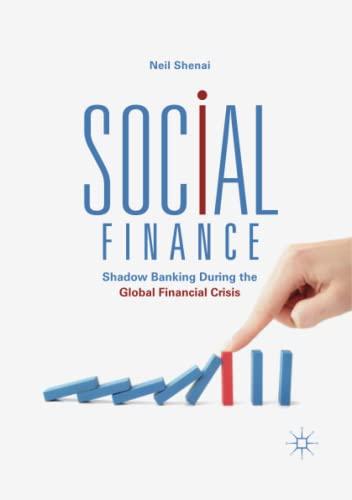Question
V2 F1 Q19-Q20 Please show workings/give explanations Note: Questions 11 20 are based on the same mega problem. For convenience we have included the entire
V2 F1 Q19-Q20
Please show workings/give explanations
Note: Questions 11 20 are based on the same mega problem. For convenience we have included the entire set of information in every question. For purposes of the questions that follow, assume that changes in working capital are negligible and capex and depreciation are of the same magnitude and therefore cancel each other. This is the assumption we made in most of the videos to focus on valuation effects of borrowing and taxes and to figure out the key differences between alternative valuation methods.
Q19) You are planning on opening a consulting firm. You have projected an EBIT of $2 million starting next year (t = 1) with a growth rate of 3% over the foreseeable future thereafter. This endeavor will require a substantial investment and you will have to convince investors to provide you the capital to do so. You will invest some of your own money, convincing other investors will of course be useful for your valuing your own investment decision. A critical piece of your analysis is figuring out the present value of the cash flows of the business. Your research has revealed the following information: similar consulting businesses equity has an average beta of 2.40 and the average debt-to-equity ratio in this industry is close to zero. The risk-free rate is 3.20% and the expected market risk premium (the average difference between the market return and the risk-free rate) is 4.50%. The corporate tax rate is 35% and interest payments on debt are tax deductible. Soon thereafter your hearing about your new business, your bank is willing to extend you long-term loan/debt in perpetuity of $3.50M as long as you can pay an interest rate of 8%. Realizing that the chances of bankruptcy are negligible with this amount of ongoing debt on your balance sheet, and the riskiness of the tax shield of debt is the same as the riskiness of debt, you decide to take on $3.50M of debt in perpetuity. Given this decision, you want to consider the Multiples Approach to Valuation as a double-check for your detailed Discounted Cash Flow (DCF) based analyses. Fortunately, there have been several market transactions in this business environment, but you want to choose the most optimal multiple to use given your decision to use a capital structure that is different from the competition where virtually no debt is used. The best multiple to use will be:
a) Either P/E or EBITDA multiple is suitable for your situation.
b) Neither P/E nor EBITDA multiple is suitable for your situation.
c) EBITDA multiple.
d) P/E multiple.
Q20) You are planning on opening a consulting firm. You have projected an EBIT of $2 million starting next year (t = 1) with a growth rate of 3% over the foreseeable future thereafter. This endeavor will require a substantial investment and you will have to convince investors to provide you the capital to do so. You will invest some of your own money, convincing other investors will of course be useful for your valuing your own investment decision. A critical piece of your analysis is figuring out the present value of the cash flows of the business. Your research has revealed the following information: similar consulting businesses equity has an average beta of 2.40 and the average debt-to-equity ratio in this industry is close to zero. The risk-free rate is 3.20% and the expected market risk premium (the average difference between the market return and the risk-free rate) is 4.50%. The corporate tax rate is 35% and interest payments on debt are tax deductible. Soon thereafter your hearing about your new business, your bank is willing to extend you long-term loan/debt in perpetuity of $3.50M as long as you can pay an interest rate of 8%. Realizing that the chances of bankruptcy are negligible with this amount of ongoing debt on your balance sheet, and the riskiness of the tax shield of debt is the same as the riskiness of debt, you decide to take on $3.50M of debt in perpetuity.The government however is seriously contemplating removing the tax subsidy to debt, that is, the deductibility of interest but not dividends from earnings before taxes are calculated. Given this information, and assuming that costs of bankruptcy are likely to be negligible, you should:
a) Change your capital structure and lower your debt.
b) Not worry about your capital structure and focus on the value drivers of your business.
c) Keep your capital structure unchanged because all your previous analysis will remain valid.
Step by Step Solution
There are 3 Steps involved in it
Step: 1

Get Instant Access to Expert-Tailored Solutions
See step-by-step solutions with expert insights and AI powered tools for academic success
Step: 2

Step: 3

Ace Your Homework with AI
Get the answers you need in no time with our AI-driven, step-by-step assistance
Get Started


